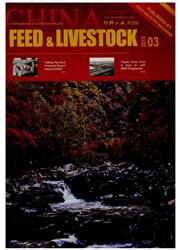

 中文摘要:
中文摘要:
研究旨在明确糟渣类副产品的物理化学特性。收集并分析了20种糟渣类副产品的化学成分和物理特性参数及其相关关系。结果表明:20种糟渣类副产品的化学成分分布范围较大,其中粗蛋白质crudeprotein,CPl,中性洗涤纤维(neutraldetergentfiber,NDF)和酸性洗涤纤维(aciddeter—gentfiber,ADF)含量分别为27-334g/kgDM,200-717g/kgDM,119-385g/kgDM;容积密度(bulkdensity,BD)为0.265—0.902kg,l,持水率(waterholdingcapacity,WHC)为2.96~14.74L/kg,干物质溶出率(drymattersolubility,DMS01)为0.574~6.577卵,灰分溶出率(ashsolubility,Ashs01)为0.018~0.446g,q。糟渣类副产品的BD与NDF显著负相关(R=一0.539,P〈0.05),与可溶性碳水化合物(wSC)显著正相关(R=0.612,P〈0.05);WHC与所有化学成分均无显著相关性(P〉0.05);DMSol与NDF显著负相关(R=-0.459,P〈0。05),与WSC显著正相关(R=0.779,P〈0.05),与Ashsol显著正相关(R=0.556,P〈0.05);Ashsol与粗灰分fR:0.527,P〈0.051显著正相关。以上可知,糟渣类副产品的物理化学参数,可以作为一项全面评价反刍动物饲料特性的有效指标,用以弥补单纯依靠饲料营养成分指标的不足。
 英文摘要:
英文摘要:
This experiment was conducted to determine the physical and chemical characterization of agro-industrial by-product. Twenty kind of agro-industrial by-products were collected and de- termined for their physical characteristics, chemical composition and the relationship of each oth- er. The results showed that the physical parameters and chemical composition of the 20 kinds of agro-industrial by-products distributed widely, crude protein (CP), neutral detergent fiber (NDF) and acid detergent fiber (ADF) contents were 27-334 g/kg DM, 200-717 g/kg DM, 119-385 g/kg DM, respectively, bulk density (BD) of the 20 kind of agro-industrial by-products was 0.265- 0.902 kg/1, water holding capacity (WHC) was 2.96-14.74 L/kg, dry matter solubility (DMSol) was 0.574-6,577 g/l, ash solubility (Ashsol) was 0.018-0.446 g/1. BD was significantly negative related with neutral detergent fiber (NDF) (R=-0.539, P〈0.05), but significantly positive related with wa- ter soluble carbohydrate (WSC) (R=0.612, P〈0.05). WHC was not significantly with any chemical composition. DMSol was significantly negative related with NDF (R=-0.459, P〈0.05) but signifi- cantly positive related with WSC (R=0.779, P〈0.05) and Ashsol (R=0.556, P〈0.05). Ashsol was significantly positive related with ash (R=0.527, P〈0.05).It is concluded that physical-chemical parameters of agro-industrial by-product can be used as effective indicators for comprehensive evaluation of ruminant feed and make up for the deficiency of relying simply on the feed nu- trients.
 同期刊论文项目
同期刊论文项目
 同项目期刊论文
同项目期刊论文
 期刊信息
期刊信息
